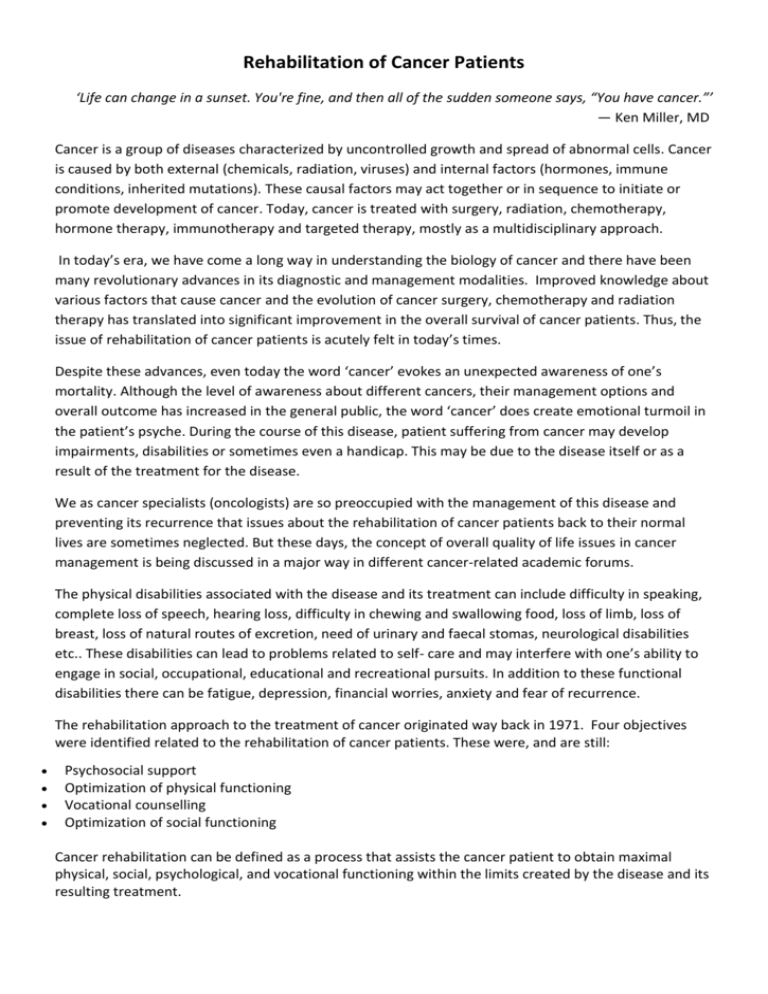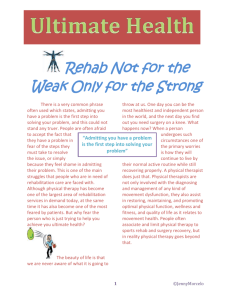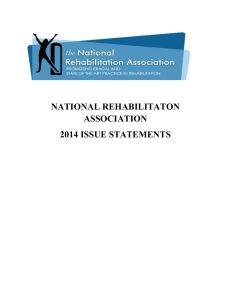READ MORE
advertisement

Rehabilitation of Cancer Patients ‘Life can change in a sunset. You're fine, and then all of the sudden someone says, “You have cancer.”’ — Ken Miller, MD Cancer is a group of diseases characterized by uncontrolled growth and spread of abnormal cells. Cancer is caused by both external (chemicals, radiation, viruses) and internal factors (hormones, immune conditions, inherited mutations). These causal factors may act together or in sequence to initiate or promote development of cancer. Today, cancer is treated with surgery, radiation, chemotherapy, hormone therapy, immunotherapy and targeted therapy, mostly as a multidisciplinary approach. In today’s era, we have come a long way in understanding the biology of cancer and there have been many revolutionary advances in its diagnostic and management modalities. Improved knowledge about various factors that cause cancer and the evolution of cancer surgery, chemotherapy and radiation therapy has translated into significant improvement in the overall survival of cancer patients. Thus, the issue of rehabilitation of cancer patients is acutely felt in today’s times. Despite these advances, even today the word ‘cancer’ evokes an unexpected awareness of one’s mortality. Although the level of awareness about different cancers, their management options and overall outcome has increased in the general public, the word ‘cancer’ does create emotional turmoil in the patient’s psyche. During the course of this disease, patient suffering from cancer may develop impairments, disabilities or sometimes even a handicap. This may be due to the disease itself or as a result of the treatment for the disease. We as cancer specialists (oncologists) are so preoccupied with the management of this disease and preventing its recurrence that issues about the rehabilitation of cancer patients back to their normal lives are sometimes neglected. But these days, the concept of overall quality of life issues in cancer management is being discussed in a major way in different cancer-related academic forums. The physical disabilities associated with the disease and its treatment can include difficulty in speaking, complete loss of speech, hearing loss, difficulty in chewing and swallowing food, loss of limb, loss of breast, loss of natural routes of excretion, need of urinary and faecal stomas, neurological disabilities etc.. These disabilities can lead to problems related to self- care and may interfere with one’s ability to engage in social, occupational, educational and recreational pursuits. In addition to these functional disabilities there can be fatigue, depression, financial worries, anxiety and fear of recurrence. The rehabilitation approach to the treatment of cancer originated way back in 1971. Four objectives were identified related to the rehabilitation of cancer patients. These were, and are still: Psychosocial support Optimization of physical functioning Vocational counselling Optimization of social functioning Cancer rehabilitation can be defined as a process that assists the cancer patient to obtain maximal physical, social, psychological, and vocational functioning within the limits created by the disease and its resulting treatment. The process of rehabilitation starts at the outset when the disease is first diagnosed. Unnecessary delays in conducting the tests should be avoided, and the patient and their family should be counselled about the diagnosis, treatment options, possible implications of the treatment and its expected outcomes. The oncologists, nurses and other medical professionals involved in patient care should bear this responsibility at various stages of cancer treatment. The patient’s near and dear ones also play a crucial role by extending caring support in all possible ways during the entire journey of cancer treatment. From one modality of treatment to the other, the various specialists involved in patient’s care need to discuss about individual patient’s specific needs and try to identify different ways of minimising treatment-related problems and maximising therapy benefits. At all stages of treatment, the patient needs continuous encouragement and assurance from the caring team. During the treatment, other professionals like physiotherapists, dieticians, speech therapists, psychiatrists and nurses, among others, co-ordinate to help the patient in as efficient a manner as possible. All these efforts, when kept in mind, help the patient in completing the therapies in effective way and making his/her road to a successful recovery easier. The psychosocial rehabilitation needs continuous dialogue with the patient. Sometimes medication is also essential to treat depression or anxiety. Special consideration should be given to the prescription of medication that may reduce pain and fatigue, improve cognitive awareness, and prevent or treat osteoporosis. Physiotherapists focus on building strength, improving mobility and counteracting fatigue. Patient needs training in those activities which help to improve balance, range of motion. Exercises are taught to prevent or treat joint contracture. Patients also need guidance about the usage of appliances to ease pain or stiffness. Occupational therapist assists the patient to achieve optimal activities to carry out day to day routine with dexterity. The occupational therapist instructs in energy-conservation strategies and advises regarding availability of equipment which can help the patient adapt appropriate postures to facilitate functions with minimum pain. Some patients, especially head and neck cancer patients, have to modify their diet after cancer surgeries. Dietician counsels the patient about recommendation of necessary dietary supplementation and deletions in the diet to restore the pre-treatment nutritional balance. Speech and language therapists have a major role in rehabilitation of patients with head and neck cancer. They address the disabilities of communication, cognition, and swallowing. Patients who undergo surgery for cancer of larynx (voice box) benefit tremendously by regular sessions with speech therapist. They also train the patients in alternative ways of communication. Recreational therapists promote desired activity that is usually performed outside the medical environment, aiding hopefulness, self-esteem, and community reintegration. Vocational counsellors guide the patients to resume working within the limits of physical and emotional capabilities. They also mediate between employers and patients in arranging modifications in work profiles and time scheduling to suit the post treatment energy levels of the patient and expectations from the employer. Altered body image due to loss of organ, disfigurement after surgical treatment, physiological changes due to treatment like chemotherapy and radiation can lead to major problems in sexual well- being of an individual. These can lead to conflicts in relationships. Sexual counselling is an essential part of rehabilitation after cancer treatment to help the patient regain healthy sexual activities. Complementary strategies such as relaxation techniques, yoga, Tai Chi, stress management, and acupuncture also have a role in improving function and lessening the side effects of nausea and pain. Patient support groups with regular get-togethers help the patient in conveying his or her individual problems in a better way. A well explained regular follow up schedule is an integral part of rehabilitation. The oncology caregiver team members and family members need to emphasise the necessity of regular visits to the oncologist. In our country, organised efforts for the development of rehabilitation strategies similar to the western world are needed. We have to identify the specific needs of an individual cancer patient and try to address them to restore his or her emotional, functional and physical well-being. Rehabilitation should be considered a part of overall cancer management. Funds should be directed to the development of rehabilitation training programs and research projects. Dr Vaishali Zamre








